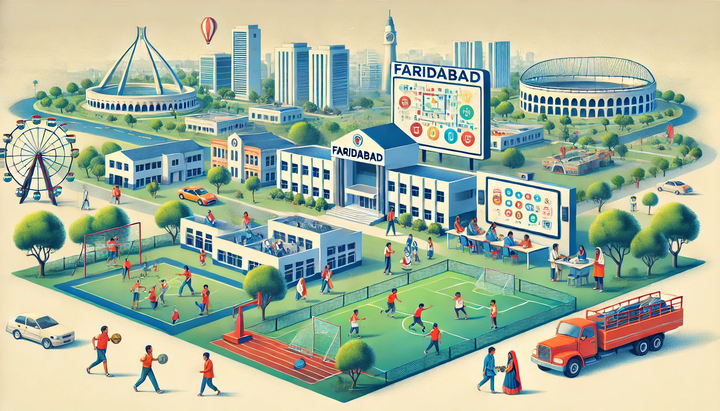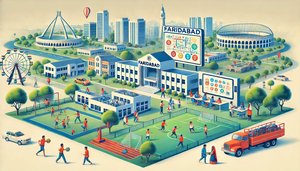How Schools Can Foster Creativity and Innovation
Corps
In today’s rapidly evolving world, creativity and innovation have become essential skills for success. Schools play a crucial role in shaping young minds and preparing them for future challenges. However, traditional education systems often prioritize rote learning over creative thinking. To cultivate a new generation of problem-solvers, critical thinkers, and innovators, schools must create an environment that fosters creativity and innovation.
Many of the Best Schools in Faridabad have recognized the importance of creativity in education and are actively integrating strategies that encourage students to think outside the box. This blog explores practical ways schools can nurture creativity and innovation in students.
Why Creativity and Innovation Matter in Education
Creativity goes beyond artistic expression—it involves problem-solving, adaptability, critical thinking, and imagination. Innovation, on the other hand, is the ability to apply creative ideas to solve real-world problems. Encouraging these skills in students equips them with the confidence and capability to face uncertainties, generate new ideas, and drive progress in any field they choose.
A curriculum that emphasizes creativity helps students:
-
Develop critical thinking skills
-
Enhance problem-solving abilities
-
Improve adaptability in changing environments
-
Encourage self-expression and confidence
-
Increase motivation and engagement in learning
Strategies for Schools to Foster Creativity and Innovation
1. Encourage Inquiry-Based Learning
Inquiry-based learning encourages students to ask questions, explore possibilities, and develop solutions on their own. Instead of simply providing answers, teachers can stimulate curiosity by posing open-ended questions and allowing students to investigate and discover information independently.
-
Example: Science classes can include hands-on experiments where students design their own investigations rather than just following textbook procedures.
2. Incorporate Project-Based Learning
Project-based learning (PBL) allows students to engage in real-world challenges that require critical thinking, collaboration, and innovation. By working on meaningful projects, students learn to think creatively while applying knowledge in practical settings.
-
Example: Students can develop solutions for local community issues, create business plans, or design prototypes for new inventions.
3. Provide a Flexible Learning Environment
Rigid classroom structures can hinder creativity. Schools should create dynamic learning spaces where students feel comfortable expressing their ideas. A flexible classroom setup with movable furniture, brainstorming zones, and access to technology encourages collaborative and creative learning.
4. Integrate Art and Music Across Subjects
Art and music stimulate creativity and should be integrated into all subjects, not just the humanities. Encouraging students to use visual storytelling, music composition, or creative writing in science and math subjects can enhance engagement and creative expression.
-
Example: In history classes, students can create short films or graphic novels to depict historical events.
5. Use Technology to Enhance Innovation
Technology is a powerful tool that can enhance creativity in the classroom. Schools should provide access to coding platforms, robotics kits, 3D printing, and virtual reality tools that allow students to experiment and innovate.
-
Example: Coding clubs and robotics competitions can inspire students to develop problem-solving skills and innovative solutions.
6. Encourage Collaboration and Teamwork
Innovation thrives in collaborative environments. Schools should promote group activities where students brainstorm, exchange ideas, and work together to solve complex problems. Team-based learning not only enhances creativity but also teaches essential interpersonal and leadership skills.
-
Example: Organizing hackathons or design thinking workshops where students work in teams to develop new ideas.
7. Promote a Growth Mindset
A growth mindset encourages students to embrace challenges, view failures as learning opportunities, and persist in the face of setbacks. Teachers should cultivate an environment where students feel safe to take risks and experiment without the fear of failure.
-
Example: Showcasing stories of famous innovators who overcame failures before achieving success can motivate students.
8. Offer Extracurricular Activities That Encourage Creativity
Extracurricular activities such as drama, music, debate, coding, entrepreneurship clubs, and DIY workshops provide students with opportunities to develop creative and innovative skills outside the traditional curriculum.
-
Example: Schools can host innovation fairs where students showcase their creative projects and inventions.
9. Encourage Reflection and Self-Expression
Journaling, blogging, and reflective discussions help students express their ideas, analyze their thinking process, and improve creative problem-solving skills. Encouraging students to reflect on their learning experiences allows them to refine their ideas and develop original perspectives.
-
Example: Assigning students to maintain creativity journals where they note down daily inspirations and innovative ideas.
10. Build Strong Mentorship Programs
Connecting students with mentors from various industries provides real-world exposure and inspiration. Schools should invite entrepreneurs, artists, engineers, and scientists to interact with students and share their creative journeys.
-
Example: Guest lectures, industry visits, and internships can help students understand how creativity and innovation are applied in different careers.
Success Stories: Schools Leading in Creativity and Innovation
Many schools worldwide have successfully implemented creative learning strategies. Here are a few examples:
-
Finland’s Education System: Finland’s schools emphasize creative problem-solving, project-based learning, and student autonomy, making them one of the most innovative education systems in the world.
-
Montessori Schools: Montessori education promotes hands-on, self-directed learning, allowing students to explore their interests and develop creative thinking skills.
-
International Baccalaureate (IB) Schools: IB programs focus on interdisciplinary learning, encouraging students to think critically and creatively across multiple subjects.
Schools that prioritize creativity and innovation create engaged, motivated, and confident learners who are well-prepared for the future.
Conclusion
Creativity and innovation are no longer optional skills—they are essential for success in the 21st century. Schools must move beyond traditional teaching methods and create learning environments that encourage curiosity, critical thinking, and problem-solving.
By integrating project-based learning, technology, collaboration, and a growth mindset, schools can empower students to think creatively and become future innovators. Many of the Best Schools in Faridabad have already taken steps to foster creativity, setting a benchmark for modern education.
By embracing a creative and innovative approach, schools can inspire the next generation of leaders, thinkers, and changemakers who will shape the future of the world.








commentaires